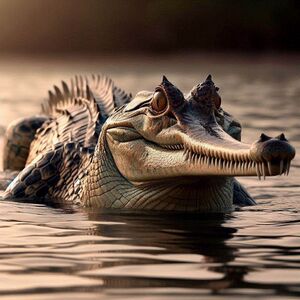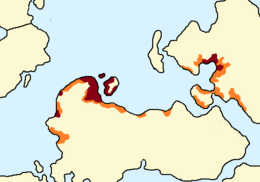Grypoeus salsavadisae
| Inyurstan Crocodile | |
|---|---|

| |
| Grypoeus salsavadisae | |
| Scientific classification | |
| Kingdom: | Animalia
|
| Phylum: | Chordata
|
| Class: | Reptilia
|
| Order: | Crocodilia
|
| Family: | Gavialidae
|
| Genus: | Grypoeus
|
| Species: | G. salsavadisae
|
| Binomial name | |
| Grypoeus salsavadisae Archíe, 1936
| |

| |
| Range of G. salsavadisae in Inyursta Red = Extant Range | |
Grypoeus salsavadisae, commonly known as the Grypo, or more formally the Estuarine Grypo; and sometimes as the Inyurstan False Gharial is a small-sized species of Gryposuchine crocodilian found in salt and brackish environments in Inyursta. Formally described in 1936, this species was informally portrayed in colonial sketches and pre-colonial Coacuendo and Rimta'alan paintings and tapestries as a smaller, longer-snouted creature which primarily preys on fish.
Physical Description
An iconic and readily-recognizable species, the Grypo has an exceedingly elongated snout and three rows of tall scutes running from behind the neck down to the tail. G. salsavadisae can be distinguished from other extant species of Grypoeus by the presence of two "horn-like" upturned scutes over both the eyes and nostrils. The hind legs are proportionally larger than the front legs, a suspected adaptation to allow quick "leaps" into deeper water or out of the water onto shore.
On average, adult males reach approximately 7ft (2.1m), but the recorded for largest recorded sits at exactly 10ft(3m) flat. Only marginally smaller, the females average around 6ft (1.8m) as adults, but like males can reach larger sizes. Females have proportionally smaller snouts than males.
Ecology
Habitat
Like most other Gryposuchinae, this species is well-adapted to saltwater environments. Typically, it is found in areas with shallow water and open, sandy bottoms. DeBron et al. (2016) found a strong correlation between water clarity and presence of this species; implying that selection for open sand is actually a byproduct of selection for specific near-shore environments which see clear tidal or riverine flows.
Female nesting habitat consists of shaded, dry banks with deep sandy soil.
Paleobiology
The genus Grypoeus is believed to have survived multiple periods of prehistoric glaciation periods and warming events in the San Jorge - Juarez Refuge. Extant species are believed to have diverged prior to the last round of glaciation. Fossil records imply that G. salsavadisae likely occupied a much wider niche in warmer prehistoric climates where higher, shallow seas and increased inland rainfall resulted in larger expanses of estuarine marshes capable of supporting a wide variety of extant crocodilians. In the modern climate of Kali Yuga, however, they are restricted to a much more specific niche.
Prey
Fish species make up the primary prey for Grypos. Schooling, near-shore species such as mullet and lady-fish compromise >90% of this species diet. A few cases of larger prey such as tarpon and even nurse sharks have been recorded. Juveniles are known to prey on crustaceans such as crabs and lobster found in more protected areas, e.g. mangrove forests & salt marshes.
Intraspecific Relationships
Where found, this species overlaps with the larger Marine Crocodile (Crocodylus salviger), another saline/estuarine resident. While crocodile-on-grypo attacks and predations are known, the two species often coexist at the community level. Marine crocodiles are also more generalist predators, taking larger, slower fish, turtles and mammals; while Grypos tend to specialize on fast-moving schooling fish which move through the shoals.
In the southwesternmost extent of their range, they overlap in basking habitats with Northwestern Caimans (Caiman andreaneinsis); but the two species otherwise show very little interaction.